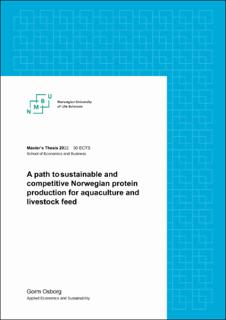| dc.description.abstract | The share of Norwegian ingredients in compound feeds for livestock and aquaculture use has been falling since 2005. Increasing domestic protein production is one of the main ways to reverse this decline. If 100% of imported proteins in livestock feed are substituted with Norwegian produced proteins, the Norwegian share is expected to increase from about 75% to 81%-83% for livestock feed. For aquafeed, if 100% of imported proteins from non-grain sources are substituted with Norwegian produced proteins, the Norwegian share in aquafeed is expected to increase from about 5.5% (2016 data) to 31.6%. Feed protein demand is estimated to increase from 987 000 metric tons (MT) in 2018 to 1 776 000 MT in 2050. 1 442 000 MT of proteins will be needed for aquafeed production and 334 000 for livestock feed production. These numbers assume a production goal of between 3-4 million MT of salmonid production by 2050. 14 promising protein production methods are evaluated, of which 8 are considered potentially viable based on criteria such as price competitiveness, sustainability and how technologically demanding production is. In total, the 8 viable methods are expected to contribute roughly 486 000 MT of proteins in 2050, in a moderate scenario. The 8 methods are mesopelagic fishing (150 000 MT), better/more roughage (120 000 MT), tunicate production (88 000 MT), increased grazing (45 000 MT), alkalized grains (30 000 MT), insect protein production (25 000 MT), meat and bone meal production (18 000 MT) and more protein- and oilseed production (10 000 MT). It is concluded that reaching full self-sufficiency of proteins by 2050 is only possible for ruminant feed, but not for other livestock feed or aquafeed, even in a best-case scenario. It may still be worthwhile to invest in domestic protein production to mitigate food security risks. The most important tool to support the growth of a domestic protein production industry is to increase R&D-funding. This is because the most promising production technologies are still in early stages of development, where progression is bottlenecked by a lack of knowledge rather than for example infrastructure or financial viability. | en_US |

